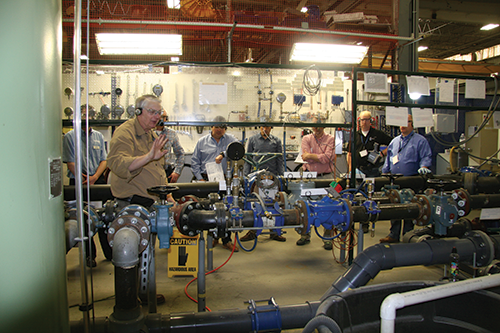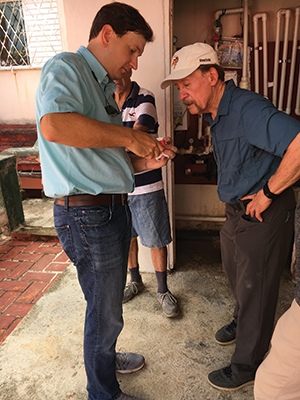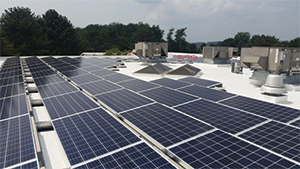In the 1970s, the Nobel prize-winning economist Milton Friedman taught us that the primary goal of a corporation should be to create profi ts and build value for the shareholders. As concerns for our environment and social challenges have grown, that philosophy has evolved. This past year, the Business Roundtable, an association of the nation’s leading CEOs, restated the purpose of a corporation to say it should include a commitment to serve other stakeholders by providing value to customers, investing in employees, partnering with suppliers, supporting communities and protecting the environment.
More than 180 top CEOs of the Business Roundtable took this pledge, and many more have become aware of social responsibilities. They are now driven to be productive corporate citizens by their employees, investors and industry members.
The valve manufacturing industry in North America is one of the industries that have embraced this new way of thinking and is leading the way with the integration of environmental, social and governance (ESG) initiatives. These initiatives range from valves designed to mitigate climate change to community involvement activities.
The reason the industry does this is that, while ESG initiatives may not directly impact a company’s bottom line, they certainly increase the value of the company in the minds and hearts of customers, employees, suppliers and communities. This article presents examples of some of the outstanding initiatives under development and practiced across the continent and the nation in the valve, actuator and controls industry. While it encompasses only a fraction of what’s being done, it illustrates where the industry is heading.
Environmental Initiatives
In North America, over 30,000 men and women in the valve industry work to supply 35% of the world’s demand for high-quality, safe and sustainable products. Without these valves, actuators, and controls, homes and factories would have no water, power, or fuel.
The manufacturing and operation of these products can have a profound effect on the environment in several ways.
The primary uses for valves have evolved and grown with centuries of progress. But the basic function still comes down to controlling the flow of fluids and preventing leakage. When fluids are pumped through valves, it is essential that the design of the valve consider energy losses from friction and turbulence. Manufacturers devote extensive research to reducing those losses as well as leakage through valves. The research has pushed forward the effort to reduce the carbon footprint of fluid systems.
Valves also often are required to control hazardous chemicals and petroleum products that emit greenhouse gases (GHG) such as methane, which has 25 times as much impact on the greenhouse effect as carbon dioxide (CO2). In the past, mechanical equipment, including valves, pumps, tanks and pipe joints, contributed to releasing significant quantities of damaging gases from refineries, chemical plants, pipelines and wastewater treatment plants.
The entire valve industry is dedicated today to meeting strict emission requirements established by the U.S. Environmental Protection Agency that will improve air quality and reduce GHG emissions.
Also, manufacturers such as Powell Valves, who has been in business since 1846, and many other long-time and newer companies, have worked with industry partners to develop American Petroleum Institute (API) standards for testing and qualifying valves with the goal of reducing fugitive emissions to near zero.
Beyond these industrywide developments are individual efforts towards environmental stewardship.
Like any factory, valve and actuator plants consume electricity, use water and transform an abundance of materials, which can result in waste and use of natural and other resources. Manufacturers such as Emerson have shown a commitment to sustainability in the way they operate and build their facilities. Emerson’s Florham Park, NJ facility, for example, was recently recognized by the New Jersey Department of Environmental Protection because the facility was designed to meet LEED Silver standards (Leadership in Energy and Environmental Design, a rating system created by the U.S. Green Building Council). This means the facility will use less water and energy and follow other steps that will reduce its greenhouse gas emissions. The building joins six other Emerson facilities that are LEED-certified, and the company has also taken other significant steps to ensure a sustainable future, including management of wetlands, diversifying arboreal investments and managing developed meadows.
In addition to seeking certification, Emerson has retrofitted many of its other buildings to use energy-saving light-emitting diode [LED] lights. The company has calculated that this will yield an estimated annual reduction of carbon dioxide emissions of nearly 11 tons and save the equivalent of about 5.5 metric tons of coal emissions.
“The major incentives for deciding to upgrade these facilities to LED lighting was energy efficiency and increased worker safety,” said Russ Kerstetter, president, Electrical and Lighting, Emerson Automation Solutions. The safety factor is based on brighter work areas.
Another effort to save energy comes from DFT Valves in Exton, PA, which installed solar panels on the roof of a facility to generate its own electricity. The system is expected to fulfill up to 60% of its electricity demand.
These efforts include both internal and external actions. Metso, a manufacturer with facilities across the globe, has a climate program that has created science-based CO2 emission targets for its suppliers, production, transportation, and product use. The company is aiming to offset energy used in business flights, push research and development projects that set energy-efficiency targets and investigate opportunities to reduce emissions that originate from its offices, employee commutes, car leasing, and much more.
Other examples of sustainability efforts include using coating processes for valves and actuators that are better for the environment. Many valve coatings have migrated from solvent-based coatings to coatings with high solids content to reduce volatile organic compounds (VOCs). Also, more advanced coatings include powder-based coatings with zero emissions such as fusion-bonded epoxy. Furthermore, a common practice for factories today is to recycle spent materials and control the input of materials in accordance with industry standards and government regulations such as Waste Electrical and Electronic Equipment and Restriction of Hazardous Substances. Both of these are European directives.
Also, as a required element of many quality management systems, excess and scrap materials are carefully controlled, segregated, and shipped to recycling centers for reprocessing, often back into the same foundries that produce castings for new valves.
David N. Farr, chairman, and CEO of Emerson, summed up how many companies feel these days with this comment:
“As part of operating responsibly, we have always sought to minimize the environmental impact of our business operations and to use energy and natural resources wisely to reduce waste, pollution, and costs.”
SOCIAL PURPOSES
Although corporations are legal entities with a profit motive, most of them today know that to be successful, they must also serve the needs of customers, employees, suppliers, and communities, not just the bottom line. Common sense dictates that industry players see customers as a top priority for the success of the company. However, that reality also goes beyond the bottom line into providing products that make that customer successful, sustainable, and a contributor of value to society.
Similarly, American Valve, which is headquartered in North Carolina, has partnered with Living Waters for the World (LWW) to provide clean water for communities in need throughout the world. American Valve’s CEO Seth Guterman, who is LWW’s board president, explains that, “I was recently in Cuba with LWW and there’s no greater return on investment than what I have seen with these systems and partnerships. Community and church leaders are taking charge of the health of their fellow citizens, and we are all blessed in the process.”
This kind of social effort is especially important today because most millennials and the generations that follow are looking for employers with a conscience. With the shortage of available people to fill an increased number of plant jobs, finding ways to reach out to those who are interested in employment is an important social consideration for most industrial companies today.
Members of the valve, actuator, and controls industry work in several ways today to attract interested and talented people from diverse backgrounds into the industry.
VMA, for example, sponsors a Valve Careers website to expose young people to the opportunities in this exciting industry. At numerous conferences and training events, companies offer training for students and young people to help them understand the products and careers within the industry.
These efforts also cement relationships between companies and their communities.
For example, DeZURIK/APCO/Hilton of Sartell, MN recently rebuilt and upgraded a vertical mill for the local high school. The mill was in disrepair so the company paid to have it upgraded, including adding a digital screen. The machine will now be used by hundreds of students every year. Another effort by that company was a weekend-long design challenge workshop created for students at St. Cloud State University.
Generous acts like this create an ongoing working relationship between industry and the community.
SOUND GOVERNANCE
The third leg of ESG involves creating corporate policies and procedures that assure companies act responsibly.
The stories about corruption on Wall Street or abandoned chemical dump sites that have threatened or destroyed our environment are all-too-common. Some of these tragedies and damage might have been avoided if the company itself knew what was going on or had outlined for its own people what is acceptable and unacceptable.
When a corporation has proper governance and oversight by a mindful board and leaders, such tragedies can be prevented.
Progressive companies today such as Mueller Water Products, Decatur, IL, put their core values in writing and make their employees commit to ethical conduct.
Core values in the industry include factors such as:
- Leadership with integrity and trust
- Respect and loyalty
- Quality and safety
- Fostering inclusion
CEOs instill these core values into the everyday operations of the company and thereby gain the trust, respect, and loyalty of customers and suppliers.
Trade associations, such as VMA, provide leadership to the industry on complying with anti-corruption and anti-trust laws to promote integrity within the industry.
Through competition and following these core values, the quality of valve products has been heightened to “world class” in North America.
Also, the industry works behind the scenes to develop and publish technical product standards through organizations such as ASTM International, the American Society of Mechanical Engineers, API, and the American Water Works Association.
North American manufacturers take it one step further and often obtain independent third-party certification to these standards. With these standards and certifications in place, the North American valve industry has gained the reputation of producing the most reliable valves, actuators, and controls in the world.
The industry is also creating safer facilities. An important concern about employees in any plant is keeping them in good health and danger-free. Many companies in the industry are developing governance policies that assure that goal.
For example, ITT Engineered valves in Lancaster, PA has named safety as one of its key operational pillars. The company was recognized as a Star Site in the Occupational Safety and Health Administration’s Voluntary Protection Program, which includes factors such as management leadership and employee involvement, worksite analysis, hazard prevention and control, and health and safety training. Such programs can influence practices industrywide.
As far as inclusion, as global manufacturers, the valve industry must adapt to diverse cultures across the globe where different levels of ethics may exist. These global efforts aim to develop diverse workforces capable of interacting with customers that practice a wide variety of customs and have many cultural beliefs and values. Global companies also counsel customers in other areas of the world on ways to make their systems more efficient.
Both on foreign soil and closer to home, one way many companies are expanding their reach is by creating opportunities for a broad, diverse group of people.
Like many companies and associations in the industry, Emerson is tackling this challenge through scholarships, grants, and programs such as STEM [science, technology, engineering, and mathematics] campaigns to provide opportunities for young people, and open more doors for women and minorities.
LOOKING AHEAD
The North American valve industry cannot solve all of society’s problems, but they can have a permanent and positive impact. The industry is working on innovative technologies to make valves safer, more efficient, and smarter to reduce the impact on the environment. As investors become more keenly aware of the positive impact of ESG initiatives, the value of valve companies as an investment opportunity will only climb upward. It is rewarding to see the firm commitment from so many companies in the valve industry. The result will be felt by people and communities for generations to come.
JOHN V. BALLUN, P.E. is the president and CEO of Val-Matic Valve & Mfg. Corp. and a regular contributor to VALVE Magazine. Reach him at jvb@valmatic.com.
Other good deeds: The programs compiled for this story are only a handful of the many ESG initiatives developed or under development by VMA members. As the magazine and association learn of these programs, they are published on VMA.org and VALVEMagazine.com (“Valve Manufacturing” news). To tell us about your programs, contact Genilee Parente, managing editor at gparente@vma.org or Barbara Donohue, web editor, at bdonohue@vma.org.
REFERENCES
1. Ballun, John V. “The Valve Industry’s Role in Climate Change,” VALVE Magazine, Winter 2017, Washington, DC.
2. Bayreuther, David. “Fugitive Emission Testing and Certification of Valves – What Next?” VMA Digital Archive, April 4, 2016. Washington, DC.
3. Bresnahan, Kristin. “Back to the ’80s: Business Roundtable’s ‘Purpose’ Statement Redux,” Directors and Boards, Third Quarter, 2019. Philadelphia, PA.
4. Emerson Corp., “2018 Corporate Social Responsibility Report,” St. Louis, MO.
RELATED CONTENT
-
Leak Testing Gas Components and Systems
Leak testing is performed for four basic reasons, says John McLaren, product manager, leak detection at Agilent Technologies, Inc.
-
HVOF Coatings for Severe Service Valves
Chrome carbide is one coating that can be done during manufacturing or repairs that extends service life of valves and other flow control components.
-
Hardfacing Alloys and Processes for Advanced Ultra-Supercritical
Cobalt-based Stellite 6 has been the workhorse for providing improved wear resistance and service life in valve components installed in power generating facilities for over 75 years.
















 Unloading large gate valve.jpg;maxWidth=214)